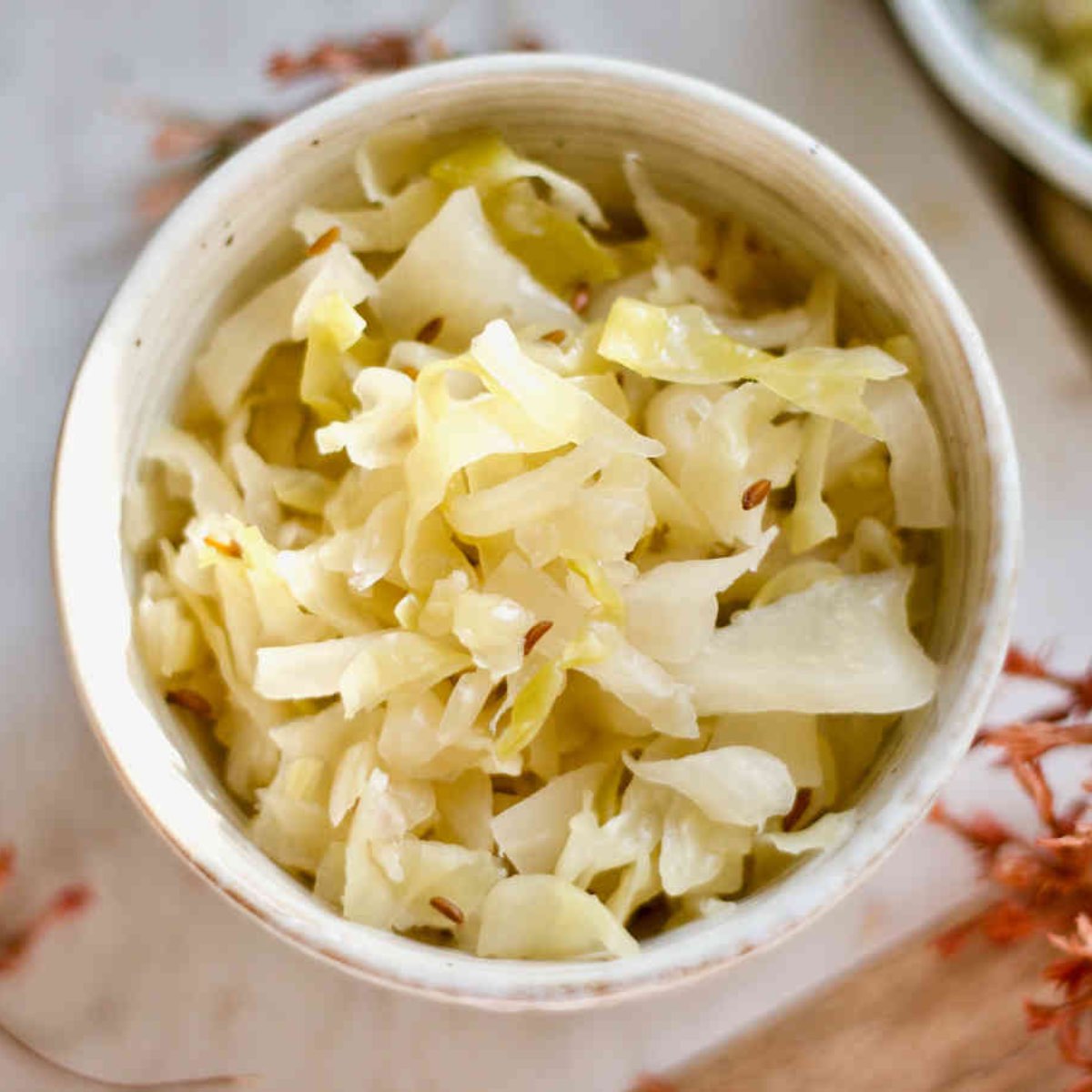Sauerkraut, the tangy fermented cabbage dish, is a delicious and healthy probiotic powerhouse. This Sauerkraut with Caraway Seeds recipe guides you through the simple process of making your own Homemade Sauerkraut with Caraway Seeds.
The addition of caraway seeds infuses the sauerkraut with a subtle licorice-like flavor, adding another layer of complexity to this classic dish. Making your own sauerkraut is a fantastic way to explore the world of fermentation and enjoy the health benefits of probiotics. It’s also a budget-friendly option and a great way to add a touch of tangy goodness to your meals.
So, are you ready to embrace the magic of fermentation and create your own jar of delicious Sauerkraut with Caraway Seeds? Let’s get started!
Difficulty: Easy
Time: 3-7 days
Sauerkraut with Caraway Seeds Recipe

Sauerkraut with Caraway Seeds Recipe Ingredients:
Making your own sauerkraut is a rewarding experience, and this recipe keeps it simple with a few key ingredients:
- Cabbage: (550 grams or 1.2 pounds) – Use green cabbage for the best results. Choose a firm head with tightly packed leaves.
- Salt: (20 grams or about 2 tablespoons) – Salt is essential for the fermentation process, and it also helps draw out moisture from the cabbage. Use non-iodized sea salt or kosher salt for this recipe.
- Water: (200 grams or about 1 cup) – Filtered or spring water is best.
- Caraway Seeds: (5 grams or about 1 tablespoon) – These aromatic seeds add a subtle licorice-like flavor to the sauerkraut.
Optional Ingredients:
- Whole Black Peppercorns: (a few) – Whole black peppercorns add a subtle peppery note to the sauerkraut.
- Bay Leaves: (a few) – Bay leaves add a hint of warmth and complexity to the flavor profile.
- Other Spices: (a pinch each) – Feel free to experiment with other spices like juniper berries, dill seeds, or fennel seeds for a customized flavor.
Sauerkraut with Caraway Seeds Instructions:
Transforming cabbage into tangy sauerkraut is a straightforward process with these steps:
-
Shred the Cabbage: Thinly shred the cabbage using a sharp knife, food processor, or mandoline. The thinner the shreds, the faster the fermentation process will be.
-
Combine with Salt: In a large bowl, combine the shredded cabbage and salt. Massage the cabbage with your hands for several minutes until it starts to wilt and release its juices. This process helps break down the cell walls of the cabbage, which is important for fermentation.
-
Add Water and Spices: Pour the water into the bowl with the cabbage and salt mixture. Stir in the caraway seeds and any other optional spices you’re using.
-
Pack into Jar(s): Transfer the cabbage mixture to a clean, non-reactive container like a glass jar or crock. Pack the cabbage mixture firmly into the jar, pressing down to remove any air pockets. The cabbage should be submerged under the brine (salty liquid).
-
Weight the Cabbage (Optional): If the cabbage doesn’t rise above the brine level, you can weigh it down with a fermentation weight or a clean glass jar filled with water. This will ensure the cabbage stays submerged and prevents mold growth.
-
Cover and Ferment: Cover the jar loosely with a lid or cheesecloth. This allows carbon dioxide to escape while preventing air and unwanted contaminants from entering. Place the jar in a cool, dark place (ideally around 68°F or 20°C) and let it ferment for at least 2 weeks.
-
Taste and Enjoy: After 2 weeks, start checking on your sauerkraut. Taste a small sample to see if it has reached your desired level of sourness. The longer you ferment it, the more tart it will become. Once it reaches your preferred flavor, store the sauerkraut in the refrigerator for up to several months.
Sauerkraut with Caraway Seeds Serving Suggestions:
Sauerkraut with Caraway Seeds is a versatile condiment that can be enjoyed in many ways:
- Classic Pairing: Enjoy sauerkraut alongside sausages, hot dogs, or bratwurst for a classic combination.
- Sandwich Topping: Add a tangy and flavorful twist to your sandwiches by adding a layer of sauerkraut. It pairs well with Reuben sandwiches, grilled cheese, or pulled pork sandwiches.
- Salad Addition: Sauerkraut adds a burst of flavor and probiotic benefits to salads.
- Digestive Aid: Enjoy a small portion of sauerkraut after a meal to aid digestion.
- Hearty Side Dish: Sauerkraut can be served as a side dish alongside roasted meats, potato dishes, or vegetarian meals.
Why Sauerkraut with Caraway Seeds Is a Great Leftover Recipe:
While not necessarily a recipe for using leftovers, making your own sauerkraut is a great way to prevent cabbage from going to waste. Here’s why it’s a fantastic option:
- Preserves Fresh Cabbage: Sauerkraut is a traditional way to preserve cabbage, allowing you to enjoy it for months after harvest. It’s a great way to use up a head of cabbage before it spoils.
- Budget-Friendly: Homemade sauerkraut is a cost-effective way to enjoy this fermented food. It requires just a few simple ingredients and minimal equipment.
- Healthy and Probiotic-Rich: Sauerkraut is a good source of probiotics, which are beneficial bacteria that support gut health and digestion.
- Customizable Flavor: This recipe offers a basic framework, but feel free to experiment with different spices and herbs to create your own unique sauerkraut flavor profile.
- Sense of Accomplishment: Making your own sauerkraut is a rewarding experience. It allows you to create a delicious and healthy condiment from scratch.


